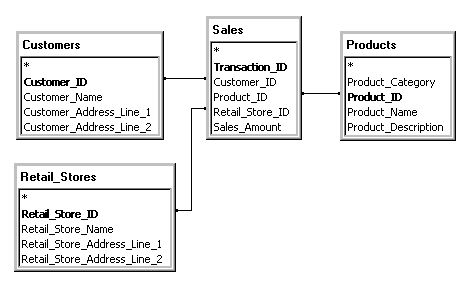Using Aggregate Functions
This topic contains examples for using the aggregate functions (Sum, Min, Max, Count, and Distinct Count) in measures. The examples for the query are based on the same cube cells as the following examples so that you can see the effects of changing the function.
The cube that these examples use has a single measure, Sales, based on the Sales_Amount column in the Sales fact table. The cube has three dimensions:
- Customers, based on the table Customers and containing these levels from highest to lowest:
- (All)
- Customer with Customer_Name as the member name column and Customer_ID as the member key column
- (All)
- Retail Stores, based on the table Retail_Stores and containing these levels from highest to lowest:
- (All)
- Retail Store with Retail_Store_Name as the member name column and Retail_Store_ID as the member key column
- (All)
- Products, based on the table Products and containing these levels from highest to lowest:
- (All)
- Product Category with Product_Category as the member name column and the member key column
- Product with Product_Name as the member name column and Product_ID as the member key column
- (All)
For more information about dimensions and levels, see Dimensions and Levels.
The cube's schema is shown here.

The cube's fact table, Sales, is shown here.
Transaction_ID |
Customer_ID |
Product_ID |
Retail_Store_ID |
Sales_ Amount |
|---|---|---|---|---|
| 1 | 1 | 1 | 1 | 300 |
| 2 | 1 | 1 | 1 | 250 |
| 3 | 1 | 1 | 1 | 250 |
| 4 | 1 | 2 | 1 | 100 |
| 5 | 1 | 4 | 1 | 700 |
| 6 | 2 | 1 | 2 | 290 |
| 7 | 2 | 2 | 2 | 90 |
| 8 | 2 | 3 | 3 | 510 |
| 9 | 3 | 1 | 4 | 350 |
| 10 | 3 | 2 | 3 | 110 |
| 11 | 4 | 3 | 4 | 550 |
| 12 | 4 | 4 | 4 | 750 |
One of the cube's dimension tables, Customers, is shown here.
Customer_ID |
Customer_Name |
Customer_Address_ Line_1 |
Customer_Address_ Line_2 |
|---|---|---|---|
| 1 | A | 1 A Street | Aville, AA 55555 |
| 2 | B | 2 B Street | Bville, BB 55555 |
| 3 | C | 3 C Street | Cville, CC 55555 |
| 4 | D | 4 D Street | Dville, DD 55555 |
Another of the cube's dimension tables, Retail_Stores, is shown here.
| Retail_ Store_ID |
Retail_Store_ Name |
Retail_Store_ Address_Line_1 |
Retail_Store_ Address_Line_2 |
|---|---|---|---|
| 1 | A | 1 A Avenue | Atown, AA 55555 |
| 2 | B | 2 B Avenue | Btown, BB 55555 |
| 3 | C | 3 C Avenue | Ctown, CC 55555 |
| 4 | D | 4 D Avenue | Dtown, DD 55555 |
The cube's final dimension table, Products, is shown here.
| Product_ID | Product_Name | Product_Description | Product_Category |
|---|---|---|---|
| 1 | A | aaaa aaaa aaaa | AB |
| 2 | B | bbbb bbbb bbbb | AB |
| 3 | C | cccc cccc cccc | CD |
| 4 | D | dddd dddd dddd | CD |